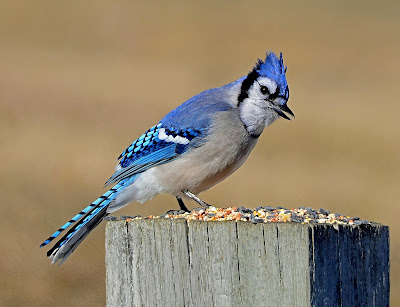Ruby-throated Hummingbirds
Nature News: Ruby-throated hummingbirds a tiny marvel
Published June 11 2019 seacoastonline.com/The York Weekly/The Portsmouth Herald/Fosters Daily
 |
| Ruby-throated hummingbird enjoying the sun Sue Pike photo |
Only one New England bird fits this description: the ruby-throated hummingbird. These diminutive birds, little more than feather-covered flight muscles, are one of the most fascinating birds to visit our yards.
I was recently asked about feeding hummingbirds. Hummingbird food mixes are available at many stores, and they’re expensive, brightly colored with red dye (a totally unnecessary additive), and supplemented with unnecessary nutrients and vitamins.
Flower nectar really is just sugar water, and research indicates that it is the fuel hummingbirds use to power their search for bugs -- insects being their main source of protein, fat, vitamins and minerals. A typical hummingbird visiting as many as 1,000 flowers a day is also pulling spiders from their webs, sucking gnats out of the air and using their tongues’ brushy tip to trap insects while lapping up nectar. The hummingbird uses the sugar in nectar, much as we use an energy bar during a 5K race as “instant” energy. I had hummingbirds frequenting my feeder earlier this spring, but now that they are nesting, the frequency of their visits has dropped off - probably because they are switching to the more protein-rich diet they need for chick-rearing.
So, the best thing you can do to attract and feed your local hummingbird is to buy a decent feeder, one that is easy to clean and fill, that has some red on it to attract hummingbirds, and fill it with sugar-water. Just measure a cup of sugar into 4 cups of water, bring the mix to a rolling boil until the sugar is dissolved, let this mix cool and pour it into your feeder. You can store the extra syrup in the refrigerator for at least a week or two. Make sure to change the syrup and clean your feeder fairly regularly; fungus and mold can be deadly.
If you plan on going away for a week or so, just bring in the feeder. Hummingbirds aren’t stupid; they generally have a feeding territory with a large number of flowers to choose from, so won’t starve in your absence.
With a feeder in front of your window, you should be able to watch hummingbirds aggressively defend their territory from all intruders. You might see the males flash their ruby gorget (throat) or get a close-up look at their tongues as they feed. Those brushy tips are an adaptation that helps the hummingbird absorb more nectar. By increasing the surface area of the tongue with numerous folds nectar is easily absorbed via capillary action, similar to how a towel absorbs water.
According to the Cornell Lab “male ruby-throated hummingbirds don’t stick around long. Pairs are together long enough for courtship and mating - just a matter of days to weeks. Then he’s off on his own, and may begin migration by early August.” The female and juvenile ruby-throats should all be gone by October, they can’t tolerate our frosts or cooler temperatures. There is an interesting urban myth that ruby-throats hitchhike rides with Canada geese, though this has been debunked. The ruby-throats fly on their own, hugging the treetops and the waves in the Gulf of Mexico as they head south.
Don’t worry about taking your hummingbird feeders down - that’s another myth: that keeping your feeder up will keep them in the north too long -- migration is mostly controlled by photoperiod -- days get shorter, they put on fat, and they leave. They can fly faster than I would have thought averaging 25 to 30 miles per hour during migration (that translates into approximately 20 hours to cross the Gulf of Mexico).
Hummingbirds don’t fly as a flock, they flew on their own up here this spring and will reverse that journey in the fall. I like to think about these tiny bundles of energy doggedly buzzing along routes that most larger animals won’t even attempt.
Susan Pike, a researcher and an environmental sciences and biology teacher at St. Thomas Aquinas High School, welcomes your ideas for future column topics. She may be reached at spike3116@gmail.com. Read more of her Nature News columns online.



Comments
Post a Comment